Fitted Tension Spline Scheme for a Singularly Perturbed Parabolic Problem With Time Delay
Abstract
A fitted tension spline numerical scheme for a singularly perturbed parabolic problem (SPPP) with time delay is proposed. The presence of a small parameter ε as a multiple of the diffusion term leads to the suddenly changing behaviors of the solution in the boundary layer region. This results in a challenging duty to solve the problem analytically. Classical numerical methods cause spurious nonphysical oscillations unless an unacceptable number of mesh points is considered, which requires a large computational cost. To overcome this drawback, a numerical method comprising the backward Euler scheme in the time direction and the fitted spline scheme in the space direction on uniform meshes is proposed. To establish the stability and uniform convergence of the proposed method, an extensive amount of analysis is carried out. Three numerical examples are considered to validate the efficiency and applicability of the proposed scheme. It is proved that the proposed scheme is uniformly convergent of order one in both space and time. Further, the boundary layer behaviors of the solutions are given graphically.
1. Introduction
Recently, a number of numerical methods have been conducted by different authors. Ayele, Tiruneh, and Derese [10] constructed a hybrid scheme of a proper combination of the midpoint upwind scheme in the outer layer region and the cubic spline method in the boundary layer region on the piecewise Shishkin mesh in the spatial direction. Das and Natesan [1] constructed a numerical scheme using the hybrid method on piecewise uniform Shishkin mesh in the space direction and an implicit Euler scheme in the temporal direction. Also, Govindarao and Mohapatra [11] constructed a numerical scheme using the hybrid scheme on Shishkin-type meshes in the space direction and an implicit trapezoidal scheme in the temporal direction. Gowrisankar and Natesan [12] proposed a numerical scheme using the upwind finite difference scheme on a piecewise uniform mesh. Salama and Al-Amery [13] constructed a numerical scheme comprising the Crank-Nicolson method for discretizing the time variable and the operator compact implicit (OCI) method in the spatial direction. Podila and Kumar [14] constructed a stable finite difference method that works on a uniform mesh and an adaptive mesh. The upwind finite difference method on Shishkin mesh is constructed in [15]. An adaptive mesh refinement approach is employed using the concept of entropy function in [16, 17]. An exponentially fitted finite difference method is considered in [9, 18]. The nonstandard finite difference scheme is considered in [19, 20] following Micken’s type discretization for the space derivatives. The authors in [7, 21] constructed the numerical techniques that work for large or small time delays. For the spatiotemporal delays differential equation, Ejere et al. [8] constructed a robust numerical technique. For the differential-difference equations, the authors in [22] developed the cubic spline in tension.
To the best of the authors’ knowledge, the fitted tension spline scheme has not been developed for solving singularly perturbed parabolic problems (SPPPs) with a time delay. As stated in [23], constructing uniformly convergent numerical methods regardless of ε is an active research area. This motivated us to look for a sound numerical method that converges uniformly regardless of ε. In this study, we developed a numerical scheme that comprises the backward Euler in the temporal direction and the fitted tension spline method in the space direction on uniform meshes. Thus, the main objective is to propose ε-uniform numerical method to treat SPPPs with a time delay.
In this study, the symbol C denotes a positive constant that is independent of ε and the mesh elements. The norm ‖.‖, denoted by , is the maximum norm.
2. Continuous Problem
0 < ε ≪ 1 and ζ > 0 are given constants; the functions κ(s), γ(s), μ(s, t), f(s, t) on and ψb(s, t), ψl(t), ψr(t) on η = ηl ∪ ηr ∪ ηb are sufficiently smooth and bounded to satisfy the following assumptions: (i) . (ii) . Under assumption (i), the solution of Problem (2) exhibits a boundary layer of width O(ε) along s = 1 [1], and under assumption (ii), Problem (2) exhibits a boundary layer of width O(ε) along s = 0 [16].
2.1. A Priori Bounds
Lemma 1 (see [1] maximum principle.)Let , given that ϕ(s, t) ≥ 0 ∀ (s, t) ∈ η and , then .
Lemma 4 (stability result). The solution z(s, t) of Equation (2) is estimated as
Proof 1. Determine the barrier functions χ±(s, t) as χ±(s, t) = ϖ−1‖f‖ + max{|ψl(t)|, |ψb(s, t)|, |ψr(t)|} ± z(s, t), on the boundaries, we get χ±(s, 0) = ϖ−1‖f‖ + max{|ψl(t)|, |ψb(s, t)|, |ψr(t)|} ± z(s, 0) ≥ 0, χ±(0, t) = ϖ−1‖f‖ + max{|ψl(t)|, |ψb(0, t)|, |ψr(t)|} ± z(0, t) ≥ 0, and χ±(1, t) = ϖ−1‖f‖ + max{|ψl(t)|, |ψb(1, t)|, |ψr(t)|} ± z(1, t) ≥ 0. Then,
Thus, from Lemma 1, χ±(s, t) ≥ 0, such that,
Therefore, the proof is done.
3. Numerical Method
3.1. The Time Semidiscretization
The local error estimate at the time step is given as en(s)≔z(s, tn) − Zn(s), n = 0(1)M.
Lemma 6. If and 0 ≤ k ≤ 2, then en is bounded as
Proof 2. The proof is considered in [26].
Lemma 7. For n = 0(1)M − 1, p = 0(1)4, then the derivative of the solution of Equations (8) and (9) satisfies the following bounds
Proof 3. For the proof, see [27].
3.2. The Spatial Discretization
The space interval divided into N equally spaced nodes with mesh length h is given as 0 = s0, s1, ⋯, sN = 1 and sm = mh, m = 0(1)N.
3.2.1. Description of the Method
3.2.2. Exponential Fitting Factor
Thus, we consider two cases of the boundary layers:
Case 1. Left-end boundary layer for κ(s) < 0.
Case 2. Right-end boundary layer for κ(s) > 0.
3.3. Convergence Analysis
Lemma 8 (discrete comparison principle). There is a comparison function such that for m = 1(1)N − 1 and if and , then for m = 1(1)N.
Lemma 9. The solution of Equation (35) satisfies
Proof 5. Let and the barrier functions defined as . On the boundaries, we obtain and . On the discretized space domain sm, m = 1(1)N − 1, we have
From Lemma 8, we obtain . Hence, the desired bound is obtained.
The next theorem provides the error bound in the spatial direction for the boundary layer along s = 1.
Theorem 1. Let Zn(s) be the solution of Equations (8) and (9) and the solution of Equation (35) satisfies the following error estimate:
Proof 6. In the space direction, the error is given as
Using the bounds in Equations (38) and (40), we obtain
From Lemma 7, we obtain
Lemma 10. For a fixed mesh and as ε⟶0, it gives
Proof 7. The proof can be done by using L’Hospital’s rule. For the details, refer to [30].
Theorem 2. The solution of Equation (35) satisfies the following uniform error estimate:
Proof 8. From Lemma 10 and Equation (41), we get
Hence, the result leads Using the sup over all ε ∈ (0, 1], we get
From Equation (42), we take two cases: when ε > h, the obtained method gives a second-order uniformly convergent. On the other hand, when ε ≪ h, the method is first-order uniformly convergent in the space direction.
Theorem 3. Let z and Z be the solutions of Equations (2) and (35), respectively. Then, the next uniform error estimate holds
4. Numerical Results
The applicability of the proposed scheme is validated using three model examples. The numerical values are given for α1 = 1/50 and α2 = 24/50. For the unknown exact solution of the model examples, we use the double mesh principle for the numerical experiment [8, 9]. Therefore, the maximum pointwise error , ε-uniform error (EN,M), the rate of convergence , and uniform rate of convergence (rN,M) are calculated by , , and rN,M = log2(EN,M/E2N,2M), respectively.
Example 1. Consider the problem [16] ∂z/∂t − ε(∂2z/∂s2) − ∂z/∂s + (1 + s2/2)z = t3 − z(s, t − ζ), (s, t) ∈ (0, 1) × (0, 2] with interval condition z(s, t) = 0, on (s, t) ∈ [0, 1] × [−ζ, 0] and the boundary conditions z(0, t) = 0 and z(1, t) = 0, t ∈ (0, 2].
Example 2. Consider the problem [1] ∂z/∂t − ε(∂2z/∂s2) + (2 − s2)∂z/∂s + sz(s, t) + z(s, t − ζ) = 10t2exp(−t)s(1 − s), (s, t) ∈ (0, 1) × (0, 2] with interval condition z(s, t) = 0 on (s, t) ∈ [0, 1] × [−ζ, 0] and the boundary conditions z(0, t) = 0 and z(1, t) = 0, t ∈ (0, 2].
Example 3. Consider the problem [15] ∂z/∂t − ε(∂2z/∂s2) + (2 − s2)∂z/∂s + (s + 1)(t + 1)z(s, t) + z(s, t − ζ) = 10t2exp(−t)s(1 − s), (s, t) ∈ (0, 1) × (0, 2] with interval condition z(s, t) = 0 on (s, t) ∈ [0, 1] × [−ζ, 0] and the boundary conditions z(0, t) = 0 and z(1, t) = 0, t ∈ [0, 2].
The , EN,M, and the corresponding rN,M of the proposed method are revealed in Tables 1–3 for each example, respectively, for different values of ε and N. These tables show that for every value of ε, monotonically decreases as the step sizes decrease, and as ε⟶0, the after showing growth and remains constant, demonstrating ε-uniform convergence of the developed method. On the other hand, the evaluated EN,M and rN,M applying the developed method are displayed in the last two rows, which support the theoretical result of the proposed method in the first-order in the space direction.
| Number of intervals N = M | |||||
|---|---|---|---|---|---|
| ε↓ | 16 | 32 | 64 | 128 | 256 |
| 2−0 | 1.5462e − 02 | 7.3069e − 04 | 3.9085e − 04 | 2.0204e − 04 | 2.0272e − 04 |
| 2−2 | 1.5462e − 02 | 7.2071e − 03 | 3.8153e − 03 | 1.9627e − 03 | 9.9539e − 04 |
| 2−4 | 2.6720e − 02 | 1.5542e − 02 | 8.3415e − 03 | 4.3205e − 03 | 2.1985e − 03 |
| 2−6 | 3.3768e − 02 | 1.8165e − 02 | 1.0080e − 02 | 5.3565e − 03 | 2.7620e − 03 |
| 2−8 | 3.2640e − 02 | 1.9397e − 02 | 1.0778e − 02 | 5.2689e − 03 | 2.8084e − 03 |
| 2−10 | 3.2691e − 02 | 1.9261e − 02 | 1.0440e − 02 | 5.4740e − 03 | 2.8614e − 03 |
| 2−12 | 3.2705e − 02 | 1.9270e − 02 | 1.0443e − 02 | 5.4337e − 03 | 2.7717e − 03 |
| 2−14 | 3.2709e − 02 | 1.9272e − 02 | 1.0444e − 02 | 5.4343e − 03 | 2.7716e − 03 |
| 2−16 | 3.2709e − 02 | 1.9272e − 02 | 1.0444e − 02 | 5.4345e − 03 | 2.7717e − 03 |
| 2−18 | 3.2710e − 02 | 1.9273e − 02 | 1.0444e − 02 | 5.4345e − 03 | 2.7717e − 03 |
| 2−20 | 3.2710e − 02 | 1.9273e − 02 | 1.0444e − 02 | 5.4345e − 03 | 2.7717e − 03 |
| EN,M | 3.3768e − 02 | 1.9397e − 02 | 1.0778e − 02 | 5.4740e − 03 | 2.8614e − 03 |
| rN,M | 0.7998 | 0.8477 | 0.9774 | 0.9359 | — |
| Number of intervals N = M | |||||
|---|---|---|---|---|---|
| ε↓ | 16 | 32 | 64 | 128 | 256 |
| 2−0 | 2.3794e − 04 | 4.2183e − 05 | 3.7942e − 06 | 4.8888e − 06 | 3.6409e − 06 |
| 2−2 | 5.0365e − 04 | 1.1446e − 04 | 1.1509e − 04 | 7.2877e − 05 | 4.0330e − 05 |
| 2−4 | 1.3155e − 03 | 3.3537e − 04 | 2.4985e − 04 | 1.4687e − 04 | 7.9172e − 05 |
| 2−6 | 4.6137e − 03 | 1.7222e − 03 | 6.5369e − 04 | 2.7011e − 04 | 1.2039e − 04 |
| 2−8 | 6.3373e − 03 | 4.5453e − 03 | 2.0441e − 03 | 7.1288e − 04 | 2.4399e − 04 |
| 2−10 | 6.3448e − 03 | 4.6914e − 03 | 2.7609e − 03 | 1.4423e − 03 | 5.9485e − 04 |
| 2−12 | 6.3459e − 03 | 4.6920e − 03 | 2.7627e − 03 | 1.4893e − 03 | 7.7151e − 04 |
| 2−14 | 6.3461e − 03 | 4.6921e − 03 | 2.7628e − 03 | 1.4893e − 03 | 7.7196e − 04 |
| 2−16 | 6.3462e − 03 | 4.6922e − 03 | 2.7628e − 03 | 1.4893e − 03 | 7.7197e − 04 |
| 2−18 | 6.3462e − 03 | 4.6922e − 03 | 2.7628e − 03 | 1.4893e − 03 | 7.7197e − 04 |
| 2−20 | 6.3462e − 03 | 4.6922e − 03 | 2.7628e − 03 | 1.4893e − 03 | 7.7197e − 04 |
| EN,M | 6.3462e − 03 | 4.6922e − 03 | 2.7628e − 03 | 1.4893e − 03 | 7.7197e − 04 |
| rN,M | 0.4356 | 0.7641 | 0.8915 | 0.9480 | — |
| Number of intervals N = M | |||||
|---|---|---|---|---|---|
| ε↓ | 16 | 32 | 64 | 128 | 256 |
| 2−0 | 6.4188e − 04 | 2.7416e − 04 | 1.2553e − 04 | 5.9884e − 05 | 2.9227e − 05 |
| 2−2 | 1.5563e − 03 | 7.0604e − 04 | 3.3503e − 04 | 1.6316e − 04 | 8.0501e − 05 |
| 2−4 | 1.6730e − 03 | 8.7110e − 04 | 4.4811e − 04 | 2.2739e − 04 | 1.1454e − 04 |
| 2−6 | 2.1755e − 03 | 1.0660e − 03 | 3.9616e − 04 | 2.0632e − 04 | 1.1480e − 04 |
| 2−8 | 2.5911e − 03 | 1.1849e − 03 | 6.9552e − 04 | 3.1188e − 04 | 1.0684e − 04 |
| 2−10 | 2.5922e − 03 | 1.2179e − 03 | 6.8897e − 04 | 3.8111e − 04 | 1.9669e − 04 |
| 2−12 | 2.5921e − 03 | 1.2179e − 03 | 6.8880e − 04 | 3.7968e − 04 | 2.0016e − 04 |
| 2−14 | 2.5921e − 03 | 1.2179e − 03 | 6.8878e − 04 | 3.7967e − 04 | 2.0014e − 04 |
| 2−16 | 2.5921e − 03 | 1.2179e − 03 | 6.8878e − 04 | 3.7967e − 04 | 2.0014e − 04 |
| 2−18 | 2.5921e − 03 | 1.2179e − 03 | 6.8878e − 04 | 3.7967e − 04 | 2.0014e − 04 |
| 2−20 | 2.5921e − 03 | 1.2179e − 03 | 6.8878e − 04 | 3.7967e − 04 | 2.0014e − 04 |
| EN,M | 2.5922e − 03 | 1.2179e − 03 | 6.9552e − 04 | 3.8111e − 04 | 2.0016e − 04 |
| rN,M | 1.0898 | 0.8082 | 0.8679 | 0.9291 | — |
The numerical solutions of the developed method for each example are revealed in Figures 1-3. From Figure 1, we verify that a strong boundary layer is maintained along s = 0 as ε⟶0. Moreover, Figures 2 and 3 have revealed that a strong boundary layer is maintained along s = 1 as ε⟶0. Further, to show the effect of ε on the steepness of the boundary layer, the solutions are depicted in Figure 4. In each figure, we observe that as ε⟶0, the width of the boundary layer decreases, which confirms the desired result, that is, the boundary layer width of O(ε). In addition, in Figure 5, the of the method is plotted by the log–log scale. From these figures, one can see that the decreases as the step size decreases for every value of ε, which confirms the ε-uniform convergence of the developed method. The comparison of the findings of the proposed scheme with the existing recently published works is revealed in Tables 4–6. As we have seen in Table 4, the results obtained in this paper have better accuracy than those of [18, 21]. In addition, in Tables 5 and 6, it is shown that the obtained results are more accurate compared to that of [21].
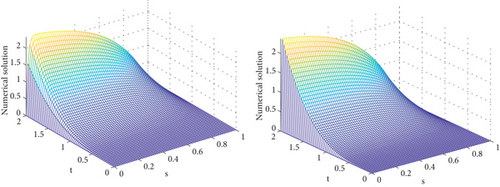
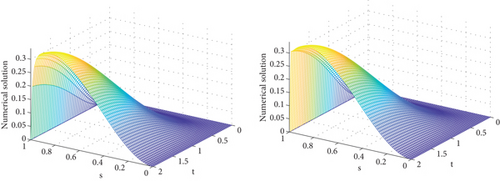
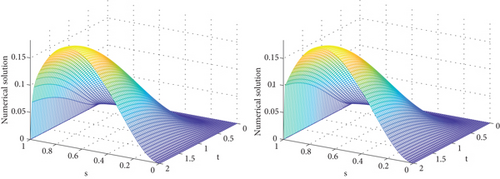
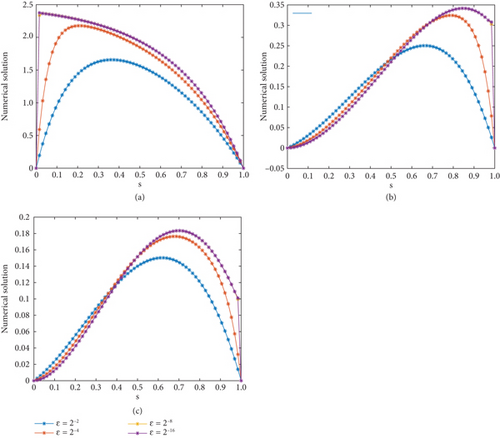
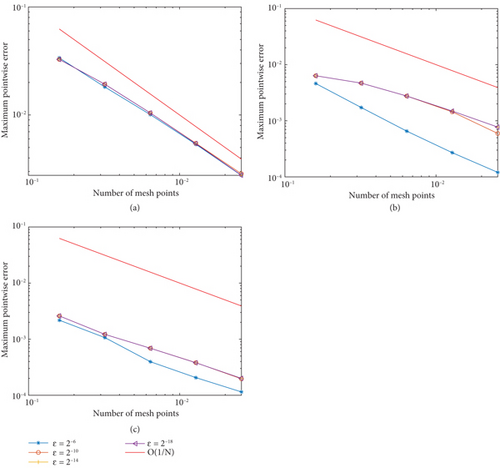
| Number of intervals N = M | |||||
|---|---|---|---|---|---|
| Schemes ↓ | 16 | 32 | 64 | 128 | 256 |
| Proposed scheme | |||||
| EN,M | 3.3768e − 02 | 1.9397e − 02 | 1.0778e − 02 | 5.4740e − 03 | 2.8614e − 03 |
| rN,M | 0.7998 | 0.8477 | 0.9774 | 0.9359 | — |
| Results in [18] | |||||
| EN,M | 3.7225e − 02 | 2.1953e − 02 | 1.1908e − 02 | 6.1994e − 03 | 3.1627e − 03 |
| rN,M | 0.76185 | 0.88249 | 0.94173 | 0.97097 | — |
| Results in [21] | |||||
| EN,M | 8.3951e − 02 | 4.9224e − 02 | 2.6666e − 02 | 1.3880e − 02 | 7.0816e − 03 |
| rN,M | 0.77019 | 0.88436 | 0.94199 | 0.97086 | — |
| Number of intervals N = M | |||||
|---|---|---|---|---|---|
| Schemes ↓ | 16 | 32 | 64 | 128 | 256 |
| Proposed scheme | |||||
| EN,M | 6.3462e − 03 | 4.6922e − 03 | 2.7628e − 03 | 1.4893e − 03 | 7.7197e − 04 |
| rN,M | 0.4356 | 0.7641 | 0.8915 | 0.9480 | — |
| Results in [21] | |||||
| EN,M | 1.1160e − 02 | 6.3269e − 03 | 3.3518e − 03 | 1.7230e − 03 | 8.7325e − 04 |
| rN,M | 0.81877 | 0.91656 | 0.96001 | 0.97086 | — |
| Number of intervals N = M | |||||
|---|---|---|---|---|---|
| Schemes ↓ | 16 | 32 | 64 | 128 | 256 |
| Proposed scheme | |||||
| EN,M | 2.5922e − 03 | 1.2179e − 03 | 6.9552e − 04 | 3.8111e − 04 | 2.0016e − 04 |
| rN,M | 1.0898 | 0.8082 | 0.8679 | 0.9291 | — |
| Results in [21] | |||||
| EN,M | 5.6185e − 03 | 2.9471e − 03 | 1.4861e − 03 | 7.4255e − 04 | 3.7060e − 04 |
| rN,M | 0.9308 | 0.98776 | 1.0010 | 1.0026 | — |
5. Conclusion
A fitted tension spline numerical scheme is constructed to solve a SPPP with a time delay. The proposed method considered the SPPP to exhibit a parabolic boundary layer in the neighborhood of the left or right side of the domain as ε approaches 0. The solution varies abruptly in the layer region due to the presence of the perturbation parameter. The problem behaves in a multiscale character where the solution has a rapid change in the boundary layer region and is uniform otherwise. Due to this, classical numerical methods on a uniform mesh lead to an oscillatory solution and thus fail to give satisfactory results. To overcome this drawback, we proposed a fitted spline numerical method. The method comprises the backward Euler in the temporal direction and the fitted spline method in the spatial direction on uniform meshes. The developed scheme gives an accuracy of first-order both in space and time direction. Three numerical examples are considered to validate the efficiency and applicability of the proposed scheme, and the results support our theoretical findings. Concisely, the presented scheme is stable, ε-uniform, and provides more accurate numerical results compared to those of others.
Conflicts of Interest
The authors declare no conflicts of interest.
Funding
The authors received no specific funding for this work.
Open Research
Data Availability Statement
All the generated data was used. No additional data were used to support the findings of this research work from other sources.




